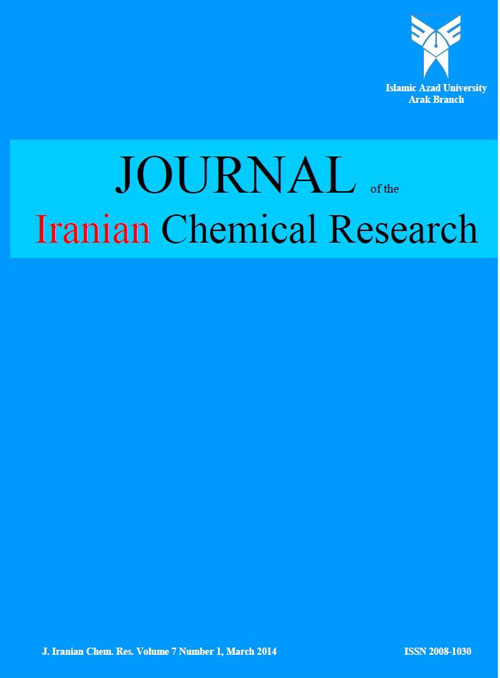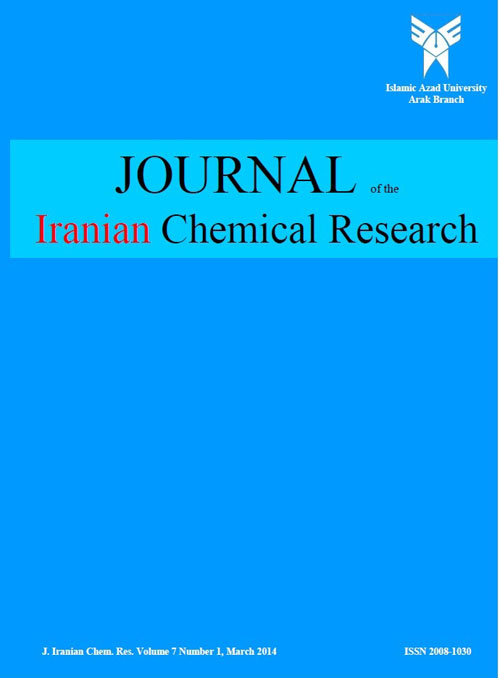فهرست مطالب

Journal of the Iranian Chemical Research
Volume:1 Issue: 2, Autumn 2008
- تاریخ انتشار: 1387/09/30
- تعداد عناوین: 8
-
Pages 79-84The traditional measurement methods of 3 kinds of aluminum species and the total aluminum content in polyaluminum solutions are Al-Ferron timed complex spectrophotometry and EDTA chelatometry respectively. But each
of these methods has different deficiencies. In this paper, microwave digesting technical had be coupled with the radiate Ferron spectrophotometry to rapid mensurate the concentration of total aluminum AlT in polyaluminum solutions. Test results show that: (1) it has a very great influence on the measured value whether the Ferron mixed chromogenic solutions after deploys different time or not, but it can been put into use immediately after microwave digested 30 s, which overcomes the weakness that must set 5 days at the traditional method; (2) Proved at the same time that it can assay quantitatively the total aluminum content in some water treatment reagents of polyaluminum solutions conveniently by microwave digesting 2 min for the mixed solutions of the Ferron mixed chromogenic solutions and the polyaluminum solutions. The feasibility of this method has been verified by modified Al-Ferron timed complex spectrophotometry at the same time .Keywords: Polynuclear aluminum, Microwave digesting, spectrophotometry -
Pages 85-94Ginger waste material (GWM) has been utilized as adsorbent for removal of hazardous Patent Blue VF (PBVF) dye from aqueous solution. Batch adsorption experiments were performed as a function of pH, contact time, dye concentration, adsorbent dose and temperature. The optimum pH required for the maximum adsorption was found to be 2. The experimental equilibrium adsorption data were tested using Langmuir and Freundlich isotherm equations and maximum monolayer adsorption capacity was found to be 9.56 mg/g. Adsorption kinetics data were modeled using the pseudo first order and pseudo second order kinetic equations and intraparticle diffusion model. Results indicate that pseudo second order model best describe adsorption kinetics data.Keywords: Adsorption, Ginger waste material, Thermodynamics, Kinetics, Isotherms
-
Pages 95-102Five new aromatic poly(amide-imide)s (5a-e) were synthesized by direct polycondensation reaction of N-(4-carboxy phenyl) trimellitimide (3) with five aromatic diamines (4a-e) by using triphenyl phosphite in N-methyl-2-pyrrolidone (NMP) and pyridine at solution containing dissolved CaCl2. All of the polymers were obtained in quantitative yields with inherent viscosities between 0.29-0.40 dL/g. The resulting poly(amide-imide)s were characterized with elemental analysis, viscosity measurements, solubility test, FT-IR spectroscopy, thermo gravimetric analysis (TGA) and differential thermal gravimetry (DTG). All of the polymers were soluble in N-methyl-2-pyrrolidone (NMP), N,N-dimethylacetamide (DMAC), N,N-dimethyl formamide (DMF), dimethyl sulfoxide (DMSO) at room temperature. N-(4-carboxy phenyl)trimellitimide (3) was prepared from the reaction of trimellitic anhydride (1) with 4- aminobenzoic acid (2) at room temperature and refluxing at 100-110°C in acetic acid as a solvent with a quantitative yield.Keywords: Poly(amide, imide)s, Polycodensation reaction, Trimellitic moieties
-
Pages 103-111An iodide ion-selective PVC membrane sensor based on copper (Π)-bis-Nphenilsalicyldenaminato complex as a novel sensing material is successfully developed. The electrode showed a good selectivity for iodide ion with respect to common inorganic anions. The sensor exhibited a good linear response with slope of _58.6 ± 0.4 mV per decade over the concentration range of 5.0 × 10-6 to 1.0 × 10-1 mol L-1, and a detection limit of 3.0 × 10-6 mol L-1 of I ion. The electrode response was independent of pH in the range of 3.0 - 10.0. The proposed sensor was applied as an indicator electrode in potentiometric titration of I with Ag ion, and to determine the iodide in sodium chloride salt.Keywords: Potentiometry, Iodide ion, selective electrode, PVC membrane, copper(?), bis, Nphenilsalicyldenaminato complex
-
Pages 113-121The possibility of application of 4-nitrocatechol (4-NC) - tetrazolium salt - organic solvent systems for liquid-liquid extraction-spectrophotometric vanadium (IV and V) speciation was studied. Six commercially available tetrazolium salts (2,3,5-triphenyltetrazolium chloride (TTC), 3-(2-naphtyl)-2,5-diphenyltetrazolium chloride (Tetrazolium Violet, TV); 3-(4,5-dimethyl-2- thiazol)-2,5-diphenyltetrazolium bromide (Thiazolyl Blue Tetrazolium, MTT), 2-(4-iodophenyl)- 3-(4-nitrophenyl)-5-phenyltetrazolium chloride (INT), 3,3-(4,4-biphenylene)bis(2,5- diphenyltetrazolium) chloride (Neotetrazolium chloride, NTC) and 3,3-[3,3-Dimetoxy(1,1- biphenyl)-4,4-diyl]bis(2,5-diphenyltetrazolium) chloride (Blue Tetrazolium chloride, BTC)) and three organic solvents (chloroform, 1,2-dichloroethane, 1-butanol) were tested in this study. The best results were obtained with MTT and chloroform. A direct, very simple, fast and sensitive procedure for vanadium (IV and V) speciation based on the spectral differences of the extracted ternary complexes of V(IV) and V(V) was developed. It was found that the optimization of the MTT to 4-NC ratio has a key role in the speciation results. At deficiency of 4-NC towards MTT the vanadium(IV) complex absorbed light at 390 and 570 nm, while the V(V) complex absorbed only at 390 nm. The corresponding molar absorptivities were calculated to be εV(IV)390 = 3.6×104 L mol-1 cm-1, εV(IV)570 = 1.7×104 L mol-1 cm-1 and εV(V)390 = 3.1×104 L mol-1 cm-1. The method was applied for vanadium (IV and V) speciation in industrial samples with low Fe and Al content (catalyst for oxidation of SO2) and good results were obtained in terms of precision and accuracy.Keywords: vanadium, Speciation, Nitrocatechol, Thiazoly blue tetrazolium, extraction, Determination, Spectrophotometric
-
Pages 123-127
Oxidation of some benzoins to benziles is reported by using p-toluenesulfonic acid as a selective oxidation catalyst under solvent-free condition in high yield. The adjacent carbonyl group is necessary for the oxidation of hydroxyl group in these compounds. The reaction is carried out in a sand-bath at 100 °C with minimum by-products.
Keywords: Benzoins, Benziles, ?, Diketones, p, Toluenesulfonic acid (PTSA), Solvent, free -
Pages 129-139A novel ternary Schiff base ligand (HL) of ONO type and its copper (II) complex were synthesised using 2-aminophenol and o-acetoacetotoluidide. They have been characterised by the usual analytical and spectral methods. The interaction of the complex with calf-thymus (CT) DNA has been investigated by UV-Vis, viscosity measurement, cyclic voltammetry and differential pulse voltammetry studies. The results show that the complex binds to CT DNA by intercalating way. The CT DNA cleavage study was monitored by gel electrophoresis method.
From this study, it was found that the complex cleaves CT DNA in presence of the oxidant, hydrogen peroxide. The in vitro antimicrobial activities of the synthesized compounds have been tested against the bacteria Salmonella typhi, Staphylococcus aureus, Bacillus subtilis, Escherichia coli, Pseudomonas putita and Klebsiella pneumoniae and fungi Aspergillus niger, Aspergillus flavus, Rhizopus stolonifer, Candida albicans and Rhizoctonia bataicola by well diffusion method. The Minimum Inhibitory Concentration (MIC) value against the growth of the above microorganisms is much larger for copper complex than the ligand.Keywords: Ternary Schiff base, DNA binding constant, Intercalative binding mode, Redox properties, CT DNA cleavage, Antimicrobial assay -
Pages 141-144Study of the ground water quality in Hodeidah is an essential ingredient for a healthy population. In this research, study of drinking water samples for eight water sources wells in the Quti field has been achieved. The purpose was to a certain the quality of water from these sources, the physical properties such as pH, electrical conductivity (EC) and total dissolved solids (TDS), showed the variation of pH (7.24-7.80),TDS (744.0-1008.6) mg L-1, within the permissible limits for World Health Organization (WHO). Except well(1) which had slight excess for TDS (100.8 mg L-1). The measurements of total hardness (TH) , NO3 -,SO4 2-, PO4 3-, Cl- , Na, K, Ca2 and Mg2 has been measured. The levels of NO3 were unacceptable by the value of (70-153) mg L-1. And SO4 2- by the range of (130-420) mg L-1, recalls exceeding the allowable values given by WHO, while Cl-, Na , Ca2 ,TH, total alkalinity and Mg2 were the permissible limits for WHO and Yemen standard (YS). The analysis data of heavy elements concentration Cr, Fe, and Mn were far from the pollution and within the permissible limits.Keywords: Ground water, Hodeidah, Yemen, Heavy elements, Chemical, physical analysis


